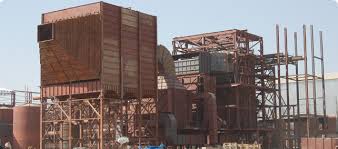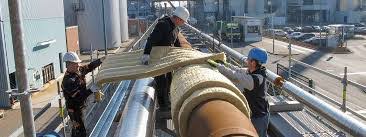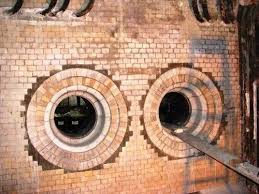Erection and Commissioning of the Boiler plays a very vital role in its life cycle. It is the stage where the boiler transitions from installation to actual operation. A properly commissioned boiler ensures safety, energy efficiency, compliance with statutory regulations, and long-term reliability.
Installing a boiler is not just about placing equipment on-site; it is a systematic process involving civil, mechanical, electrical, and safety considerations. A properly installed boiler ensures efficiency, safety, and long-term reliability
Boiler installation involves following steps;

1-Boiler main structure erection:
It involves:
- Erection of boiler columns, beams, and platforms.
- Alignment and levelling of structural members.
- Welding and bolting as per design specifications.
2-Drums (Steam drum and Water drum) Lifting & Placement
The boiler drum is the heaviest and most critical component. It is lifted using EOT cranes or hydraulic jacks and positioned at the correct elevation, later alignment is checked as per engineering drawings.
3-Pressure Parts Erection
This involves following activities;
- Installation of water walls, headers, risers, down comers, and superheaters.
- Tube-to-tube and tube-to-header welding under IBR supervision.
- Non-destructive testing (NDT) of weld joints.
4-Auxiliaries, Accessories & Piping Installation:
- This involves, Boiler Auxiliaries mainly Fans, pumps, soot blowers, Air Pre-Heaters and related air and flue gas ducts installation.
- Also, Erection of main steam piping, feedwater lines, blowdown lines, and auxiliary steam connections, attemperator lines, drain lines and related valves and fittings etc
- Installation of Bed plates and fuel and air nozzles in AFBC kind boilers and installation of Travelling grate in Travelling grate Boilers
5-Refractory/sealing, Insulation & Cladding.

Refractory is one of the most critical aspects of boiler erection and commissioning. While steel provides the strength and structure of a boiler, it is refractory that ensures protection from extreme temperatures, corrosion, and erosion inside the furnace. Without proper refractory application, even the most advanced boiler may fail prematurely.
Following are the areas where refractory is applied

- Furnace Walls & Roof
- Burner Throats & Wind box
- Boiler bank zones
- Boiler Bed
- Near Man hole doors
- Front ash discharge hoppers
- Cinder recovery hoppers
After installation of all pressure parts, air and flue gas ducts Boiler’s all hot surfaces will be insulated with desired quality of Insulation. Insulation mainly used are Ceramic, rock wool and mineral wools of density ranging from 80 kg/m3 to 150 kg/m3.
For cladding, Low density and thickness varying from 0.6 to 0.7 mm Aluminium sheets are used.
What are the different range of Insulation thickness used in Boilers??
The thickness of insulation in boilers depends on operating pressure, surface temperature, location (indoor/outdoor), and insulation material used.
- Main steam line-100 mm
- Boiler steam and water drum-100-200 mm
- Main steam line and water wall header drain lines-50-75 mm
- Main steam line and water wall headers-100 mm
- Feed water piping-75 mm
- Economiser-175-100 mm
- Air Pre-heater-75 mm
- ESP-50-75 mm
- IBD and CBD tanks-50 mm
- Flue gas ducts-50-75 mm
What are the different types of refractory used in Boilers?
- Fireclay Refractory
- High Alumina Refractory
- Insulating Refractory
- Silica & Magnesia Refractory
- Castable Refractory
What do you understand by the name Boiler commissioning?
Boiler commissioning is the systematic process of inspecting, testing, and starting up a newly installed or overhauled boiler to confirm that it operates as per the manufacturer’s specifications and regulatory requirements.
Does commissioning of the Boiler really a NEED?
Yes, systematic commission of the Boiler is very must before putting it into the Operation. Like commission of the Boiler, Boiler installation also a plays same role.
Boiler commissioning is required to ensure;
- Safety – Verifies that mountings, safety valves, pressure gauges, and control systems are functioning properly.
- Performance Guarantee – Confirms boiler efficiency, fuel consumption, and steam output.
- Regulatory Compliance – Satisfies requirements under the Indian Boiler Regulations (IBR) or equivalent standards.
- Commissioning activity Identifies installation or material defects before full-scale operation.
- Ensures proper water treatment, combustion settings, and automation tuning.
What are the different steps involved in Boiler Commissioning??
Pre-checks before commissioning
- Before carrying out the commissioning activities ensure Boiler is installed as per design drawings.
- Ensure Skilled and competent man power is available for Boiler commissioning.
- Ensure Job specific Personal Protective Equipment are available with all operating team
- Inspect piping, valves, mountings, and refractory works.
- Ensure proper alignment of the boiler with auxiliaries (feed pumps, fans, burners).
- Ensure availability of DM water and DM plant is ready to generate water as per requirement.
- Ensure Electrical and Instrumentation all activities are completed as per protocols
- Ensure all equipment satisfactory trials have completed
- Ensure DCS system is in line and healthy
- Ensure Boiler’s all protections and interlocks are healthy
- Ensure Boiler’s all steam headers have thermal expansion pointers
- Ensure ash handling system is healthy
- Ensure proper Communication system before carrying out the Boiler commissioning activities. Walky-Talky, Public Annunciators etc are critical communication used during Boiler commissioning
Various steps in Boiler commissioning:
1-Boiler Hydraulic test
This is the first step carried out for Boiler commissioning, this test is carried out as per IBR regulation No.379.
Procedure;
While filling the boiler with water, the air vent valves (usually located at the boiler drum’s highest point and headers) are kept open. This allows trapped air to escape, ensuring that the boiler is completely filled with water (air pockets can give false pressure readings and cause unsafe conditions).
Then Boiler is filled with Demineralised water (DM water). Ensure the temperature of the water is 20 to 50 Deg C and the parameters of the water are as per Boiler manufacture Hydrostatic Test:
- After vent out of the Boiler, start closing the air vents. Ensure air vents should be closed at pressure more than 2 Kg/cm2.
- Raise the Boiler pressure slowly at the rate of 3.5 Kg/cm2 per minute up 150% of maximum working pressure at the Super heater outlet as certified by the Inspecting authority.
- Note: The boiler shall be hydraulically tested in between 125% to 150% of maximum working pressure of the Boiler’s any component.
- During Hydraulic test, ensure that Boiler pressure never exceeds 6% of the required pressure.
- After reaching the desired Hydraulic pressure hold the Boiler at the same pressure for 30 minutes.
- Later reduce the pressure to maximum working pressure and inspect the Boiler all pressure parts thoroughly.
- The boiler should withstand this pressure sufficiently without any leakages and undue deflection or distortions of its any of the part.
- If Hydraulic test found satisfactory, then Boiler pressure can be reduced if not, attend the leakages or any issues and reconduct the test.
- Note: During Boiler pressure rising, carryout water wall header flushing at 5 Kg/cm2 and 10 Kg/cm2 to ensure sediments & foreign materials accumulated during installation of the pressure parts are removed from the Headers.
Additionally, headers can also be flushed out during reducing the Boiler pressure after Hydraulic test.
2-Boiler Refractory Dry out:
Refractory dry out is the controlled heating process carried out after installation or repair of refractory lining, in order to safely remove moisture and set the refractory material for full-strength operation.
It involves a carefully designed temperature ramp-up schedule to gradually evaporate free water and chemically bound water without causing structural failure of the refractory lining.
Why Refractory Dry Out is Necessary?
Moisture Removal – Refractories absorb moisture during mixing and installation. If exposed suddenly to high temperatures, trapped steam expands rapidly, leading to cracking or bursting.
Prevent Explosions – Sudden steam generation can cause refractory pieces to blow out, damaging boiler walls or tubes.
Enhance Life of Refractory – Proper dry out ensures durability and prevents premature failure.
Achieve Design Strength – Dry out allows the refractory to cure and attain its designed mechanical and thermal properties.
Safe Boiler Operation – Prevents unexpected shutdowns and increases reliability.
3-Alkali Boil out:
This is carried out to remove oil and grease accumulated on pressure parts internals during manufacturing and installation.
Alkali Boil Out is a cleaning process of the boiler’s internal surfaces using alkaline chemicals under operating temperature and pressure conditions. It helps in removing oily, greasy deposits, fabrication oils, and other organic contaminants from boiler tubes and drums before the boiler is put into service.
It is a mandatory pre-commissioning activity in thermal power plants, process boilers, and industrial boilers to ensure safe and efficient operation.
What are the Objectives of Boiler Alkali Boilout?
- Removal of oil and grease – Eliminates residual hydrocarbons left during manufacturing, erection, and handling.
- Removal of oil and grease – Eliminates residual hydrocarbons left during manufacturing, erection, and handling.
- Prevention of tube failures – Grease and oil act as insulating layers, causing tube overheating and ruptures.
- Safe operation – Prevents foaming, carryover, and contamination of steam.
What are the chemicals used for Boiler Alkali Bailout?
Caustic Soda (NaOH), Trisodium Phosphate (Na₃PO₄) and Detergents/Non-ionic wetting agents
At what pressure of the Boiler usually Alkali boil out is carried out?
Boiler Alkali boil out is carried out at 40-50% of Boiler working pressure
4-Steam Blowing:
Steam blowing is the process of passing high-velocity steam through the steam piping system to remove construction debris such as: Weld slag, Rust and scale, Sand and dirt and Oil, grease, or foreign materials.
The objective is to achieve a level of cleanliness that ensures no damage to turbine blades or other sensitive equipment during operation.
5-Boiler Safety Valve Setting:
Safety valve floating refers to the controlled manual lifting or operation of the safety valve during boiler steaming to ensure that it lifts (pops) at the set pressure and reseats correctly without leakage. This process confirms that the valve is not stuck, corroded, or jammed and can provide immediate relief in case of abnormal pressure rise.
Why is Safety Valve Floating Important?
- Prevents Sticking of Valve
- Ensures Proper Functioning
- Compliance with Boiler Regulations
- Avoids Dangerous Overpressure Situations
- Maintains Boiler Efficiency and Reliability
6-Final Trial Run & Performance Test:
Operate boiler under load, Check efficiency, fuel consumption, and steam quality. Fine-tune burner and combustion controls.
Record all test results, calibration reports, and IBR certifications, prepare an operation and maintenance logbook and Officially hand over the boiler to the operations team.


